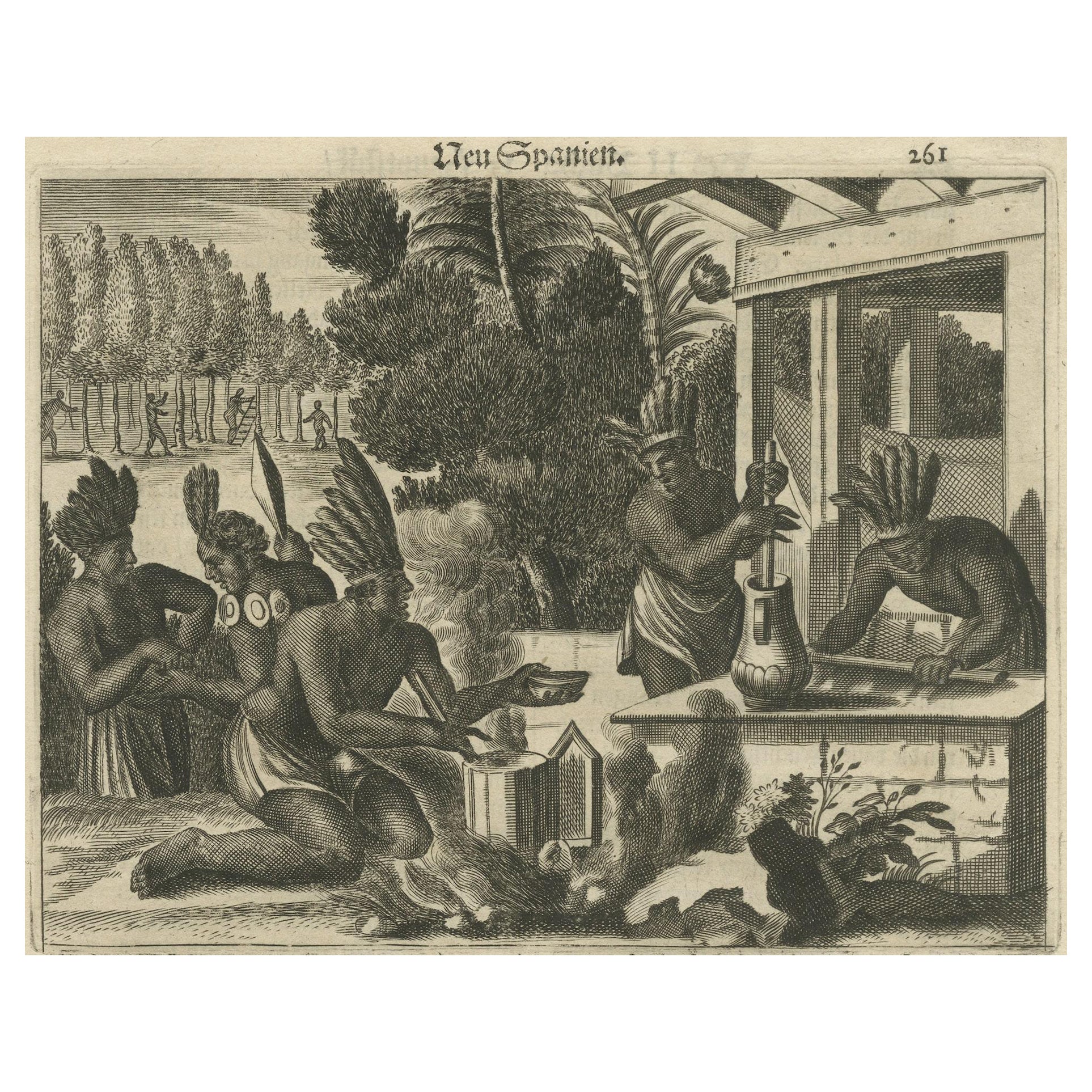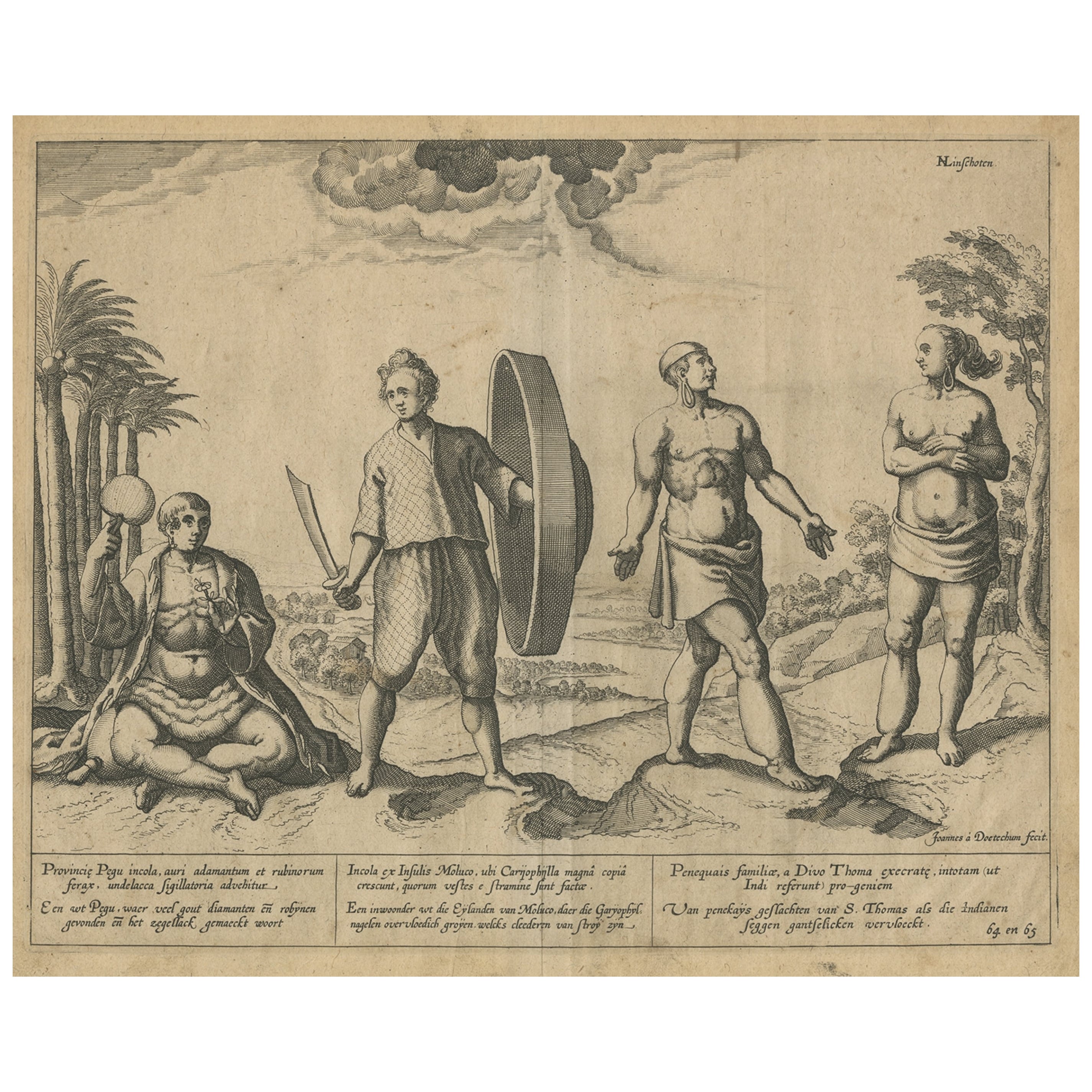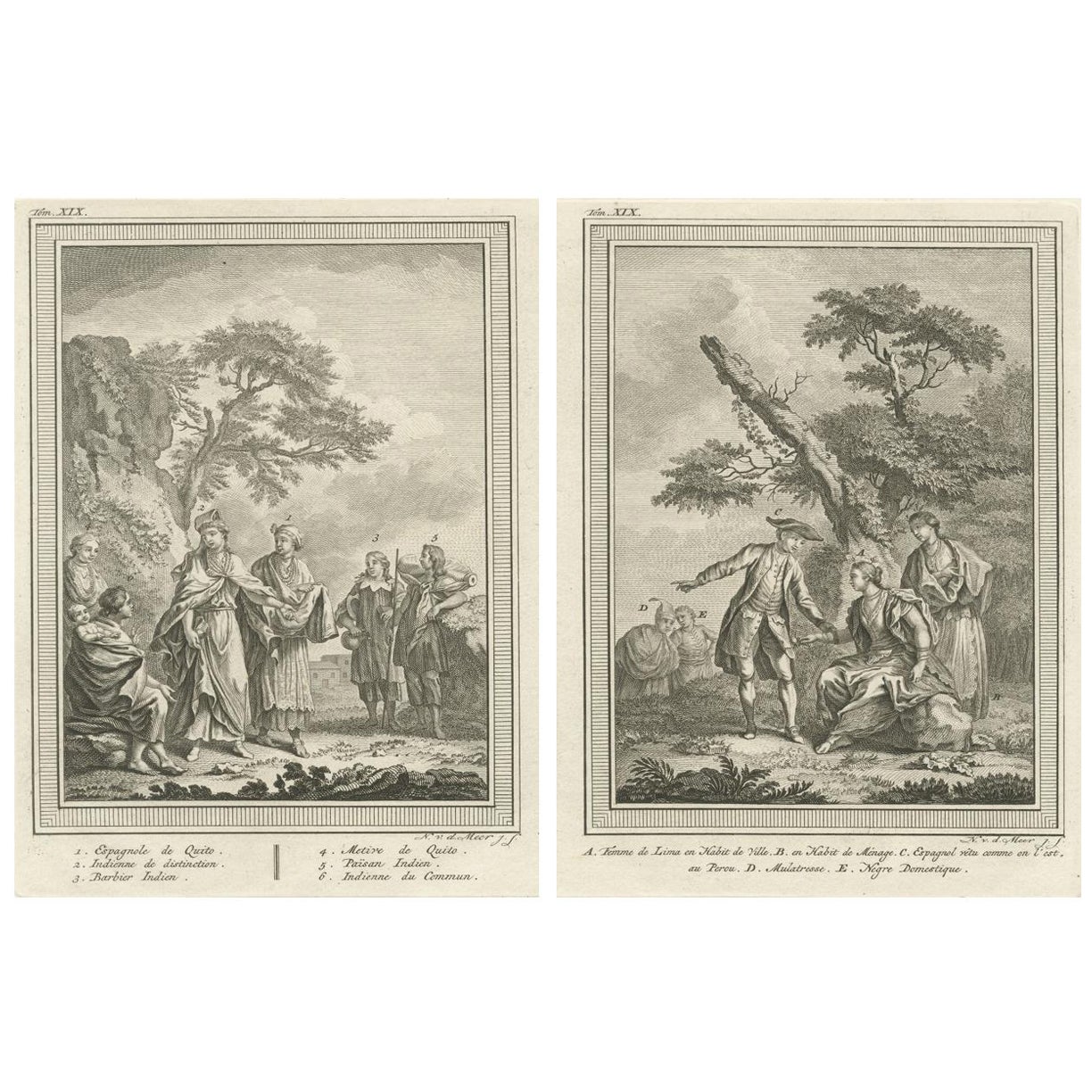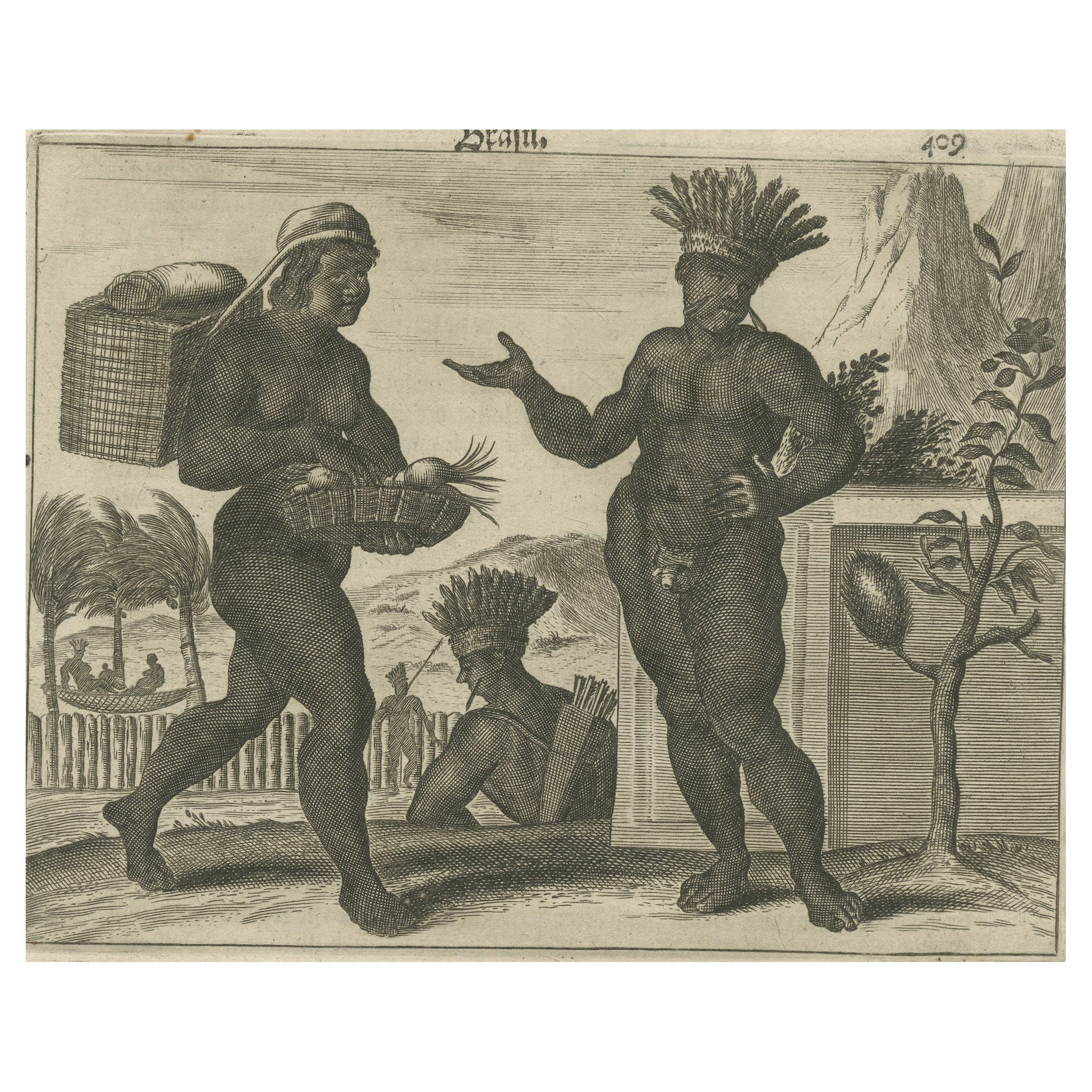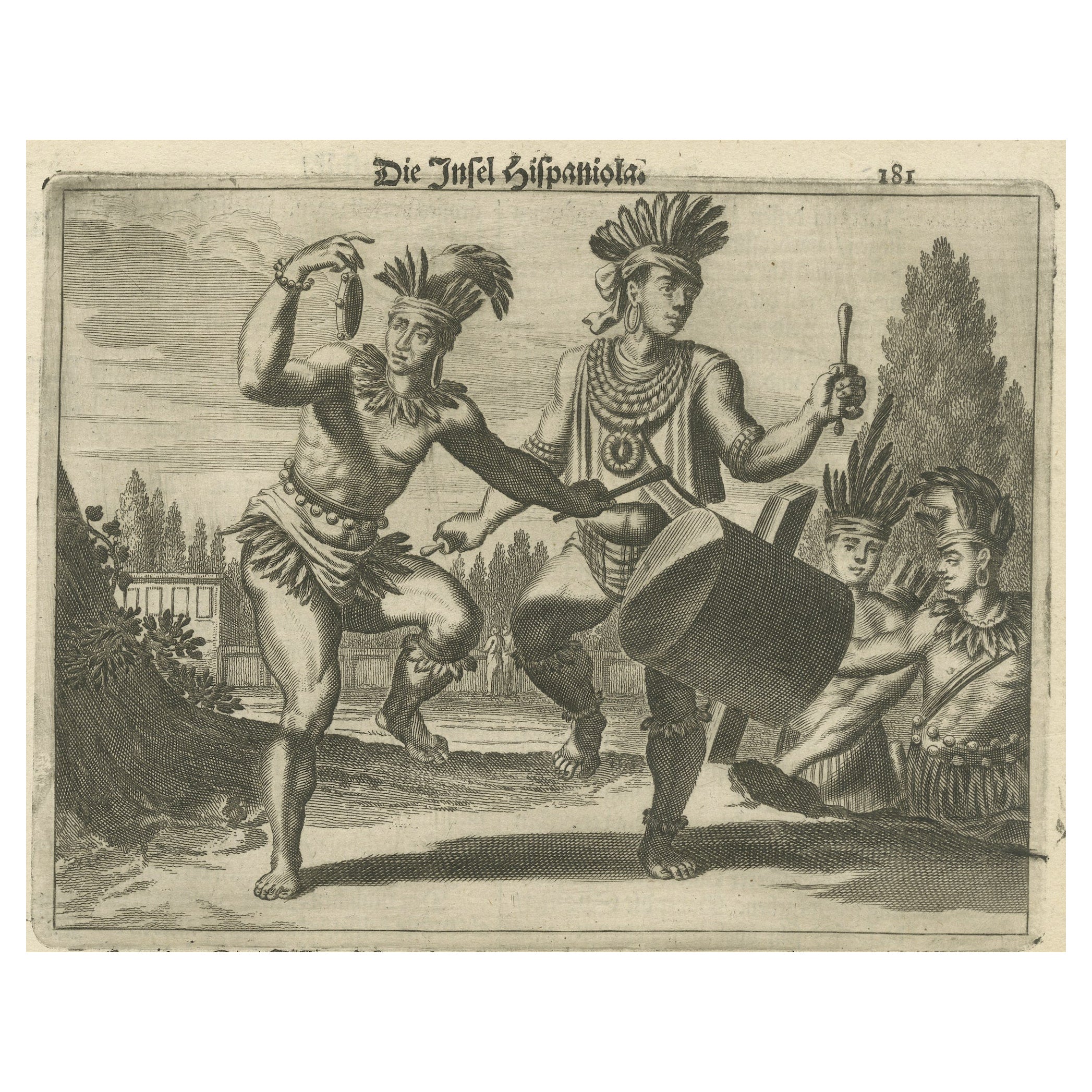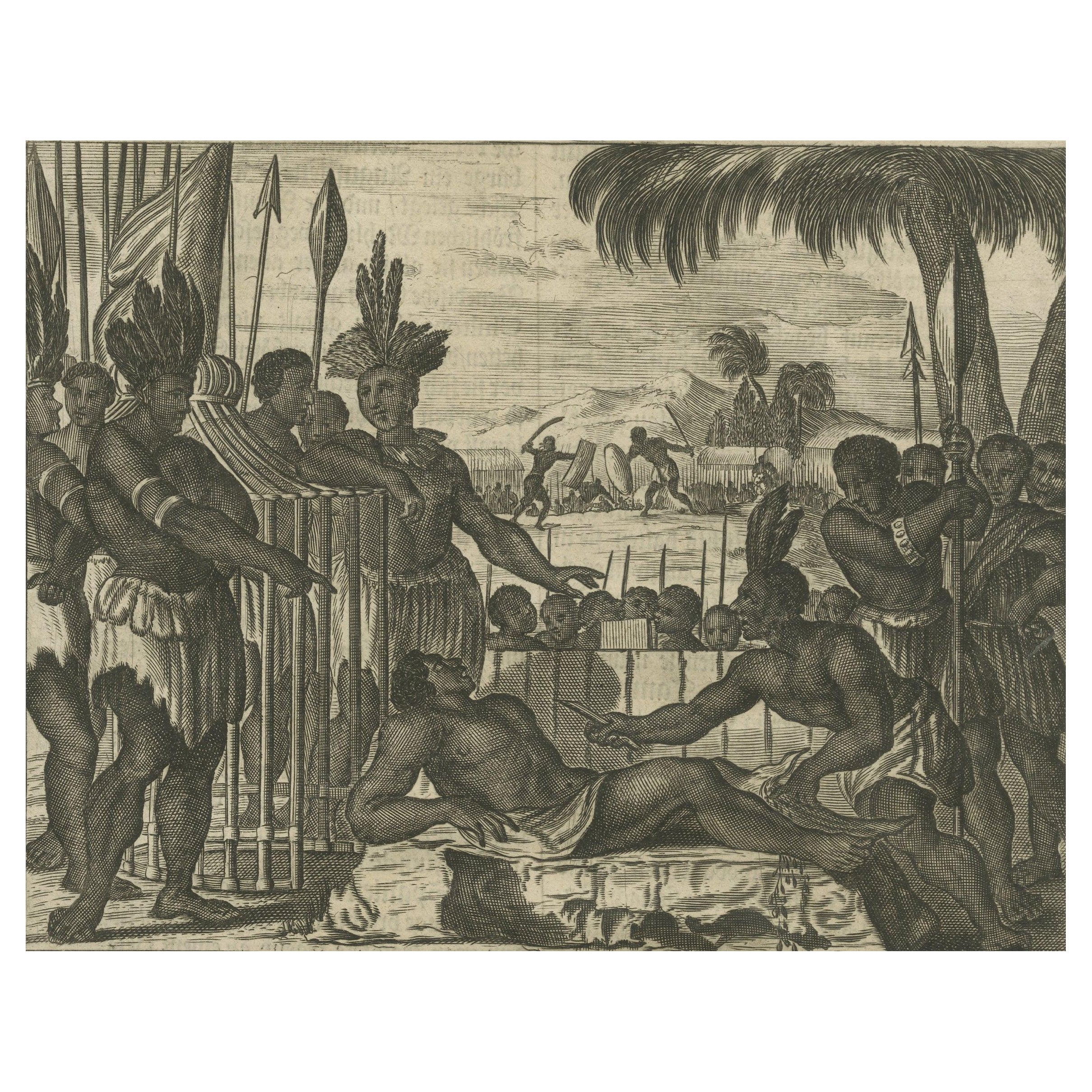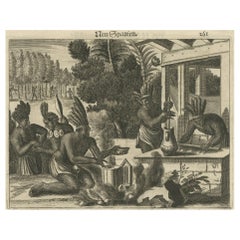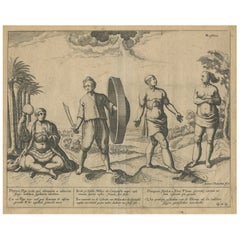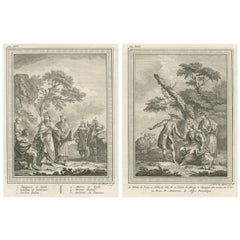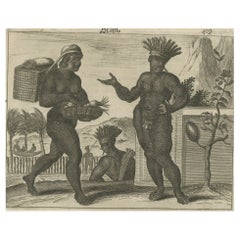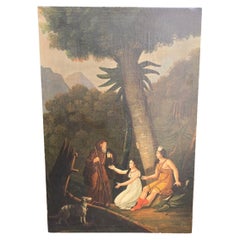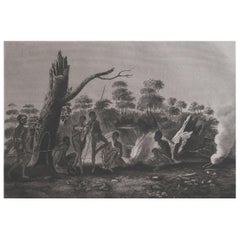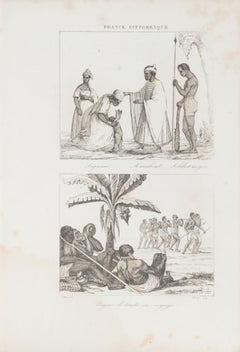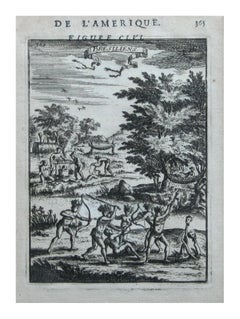Items Similar to Scenes from 17th Century Chile: A Glimpse of Early Indigenous Cultures, 1673
Want more images or videos?
Request additional images or videos from the seller
1 of 6
Scenes from 17th Century Chile: A Glimpse of Early Indigenous Cultures, 1673
$427.91
$534.8820% Off
£318.66
£398.3220% Off
€360
€45020% Off
CA$590.78
CA$738.4820% Off
A$654.97
A$818.7120% Off
CHF 344.21
CHF 430.2620% Off
MX$8,015.74
MX$10,019.6820% Off
NOK 4,298.85
NOK 5,373.5720% Off
SEK 4,034.90
SEK 5,043.6320% Off
DKK 2,740.92
DKK 3,426.1520% Off
About the Item
The image is a historical copper engraving from 1673, taken from the German edition of Arnoldus Montanus' work, which is known for its depiction of the Americas and the Southern lands. It illustrates the cultural diversity of the New World with a series of figures in various attire, representing the indigenous peoples and possibly early European settlers or explorers.
The background shows a landscape that could be indicative of the natural environment of the region at that time. The attire of the figures and the items they carry or wear would be of particular interest to historians, as these details provide insights into the daily lives, social structures, and economies of the depicted cultures.
The title of this original copper engraving, which indicates that these individuals are from Chile (referred to as "Chili" in the text), suggests that it is intended to depict scenes from that specific region of South America. The engraving is likely to illustrate the attire, customs, and daily activities of the indigenous peoples of Chile and possibly interactions with European explorers or settlers, typical of the period it was created.
The detailed attire and objects carried by the figures would be reflective of the cultural practices and the environment of Chile in the 17th century. The text accompanying the image would typically provide further explanation and context, enhancing the viewer's understanding of the depicted scene and its cultural significance.
Condition Report: The print is a fine example of 17th-century copperplate engraving, published by Jacob Meurs in Amsterdam in 1673. Considering its age, the page appears to be in good condition. It has some signs of aging such as foxing, discoloration, or edge wear or loss typical of paper artifacts of this period. The integrity of the image and text seems to be intact, with no significant tears or losses to the central depiction, making it a valuable piece for collectors of early American historical prints.
- Dimensions:Height: 12.21 in (31 cm)Width: 7.49 in (19 cm)Depth: 0 in (0.02 mm)
- Materials and Techniques:Paper,Engraved
- Period:1670-1679
- Date of Manufacture:1673
- Condition:Expected age-related tonality changes and potential marginal foxing. The paper shows signs of handling, such as soft creases and wear along left edge. Please study the image carefully.
- Seller Location:Langweer, NL
- Reference Number:Seller: BG-13596-321stDibs: LU3054337765962
About the Seller
5.0
Recognized Seller
These prestigious sellers are industry leaders and represent the highest echelon for item quality and design.
Platinum Seller
Premium sellers with a 4.7+ rating and 24-hour response times
Established in 2009
1stDibs seller since 2017
2,609 sales on 1stDibs
Typical response time: <1 hour
- ShippingRetrieving quote...Shipping from: Langweer, Netherlands
- Return Policy
Authenticity Guarantee
In the unlikely event there’s an issue with an item’s authenticity, contact us within 1 year for a full refund. DetailsMoney-Back Guarantee
If your item is not as described, is damaged in transit, or does not arrive, contact us within 7 days for a full refund. Details24-Hour Cancellation
You have a 24-hour grace period in which to reconsider your purchase, with no questions asked.Vetted Professional Sellers
Our world-class sellers must adhere to strict standards for service and quality, maintaining the integrity of our listings.Price-Match Guarantee
If you find that a seller listed the same item for a lower price elsewhere, we’ll match it.Trusted Global Delivery
Our best-in-class carrier network provides specialized shipping options worldwide, including custom delivery.More From This Seller
View AllCopper Engraving of Daily Life in New Spain in The 17th Century, 1673
Located in Langweer, NL
This original copper engraving depicts a lively scene of daily life in New Spain from Arnoldus Montanus' "Die Unbekannte Neue Welt oder Beschreibung des Welt-teils Amerika und des Su...
Category
Antique 1670s German Prints
Materials
Paper
$427 Sale Price
20% Off
Natives from Pegu, the Moluccan Islands, Penequais Indians and St Thomas, c.1605
Located in Langweer, NL
Antique print titled 'Provincie Pegu incola (..) - Incola ex Insulis Moluco (..) - Penequais familiae (..)'.
Old print showing various figures including a man from Pegu, a man fr...
Category
Antique Early 1600s Prints
Materials
Paper
$342 Sale Price
20% Off
18th Century Ethnological Engravings of Peruvians and Ecuadorians
Located in Langweer, NL
Title: 18th Century Ethnological Engravings of Peruvians and Ecuadorians
Description: These two 18th-century engravings, printed in 1756, are detailed depictions of the social and cultural life in Peru and Ecuador during the colonial era. Created by Quentin-Pierre Chedel (1705–1762), they are part of *Histoire générale des voyages* by Antoine François Prévost, a monumental collection that documented the world's exploration and cultural encounters.
First Engraving (Residents of Peru):
This print illustrates the residents of Lima, Peru, highlighting the various social classes and ethnic groups present in the region during the colonial period. The detailed engraving captures:
A. Femme de Lima en Habit de Ville – A woman from Lima in formal city dress, representing the elite of society.
B. Femme en Habit de Ménage – A woman in household dress, typical of a middle or upper-class domestic attire.
C. Espagnol vêtu comme on l’est au Pérou – A Spanish man dressed as one would in Peru, showing the influence of Spanish colonial fashion on local attire.
D. Mulatresse – A woman of mixed African and European descent, reflecting the diverse ethnic makeup of colonial Peru.
E. Nègre Domestique – A domestic servant of African descent, showcasing the role of enslaved individuals in colonial households.
The scene is set in a lush, natural landscape, with attention to the differences in social standing and attire.
Second Engraving (Residents of Quito, Ecuador):
The second engraving, although similar in style, depicts residents of Quito, Ecuador, and provides an ethnological view of the city’s diverse inhabitants. The composition shows:
1. Espagnole de Quito – A Spanish woman of high status, dressed elegantly, representing the colonial upper class in Quito.
2. Indienne de Distinction – An Indigenous woman of notable status, likely representing the local nobility or important community figures.
3. Barbier Indien – An Indigenous barber, reflecting the occupational diversity and social roles of the Indigenous population in colonial society.
4. Métive de Quito – A Métis woman from Quito, showing the mixed-race population that emerged during the colonial era.
5. Paysan Indien – An Indigenous farmer, indicating the essential role of agriculture and rural labor in the economy of colonial Ecuador.
6. Indienne du Commun – A common Indigenous woman, dressed in traditional attire, representing the majority of the Indigenous population.
Like the first engraving, this print captures the varied ethnic and social dynamics in a colonial society, with figures placed in a landscape setting, emphasizing the connection between people and their environment.
These engravings are not only artistic representations but also important historical records of colonial Latin America...
Category
Antique Mid-18th Century Prints
Materials
Paper
$323 Sale Price / set
20% Off
Daily Life in Brazil in the early 17th Century on a Copper Engraving by Montanus
Located in Langweer, NL
"Daily Life in Brazil"
This striking copper engraving, part of Arnoldus Montanus' "Die Unbekannte Neue Welt oder Beschreibung des Welt-teils Amerika und des Sud-Landes", presents a ...
Category
Antique 1670s Dutch Prints
Materials
Paper
$374 Sale Price
30% Off
Copper Engraving of Hispaniola - Indigenous Life in America by Montanus, 1673
Located in Langweer, NL
This original copper engraving, extracted from the scarce German edition of Arnoldus Montanus' "Die Unbekante Neue Welt oder Beschreibung des Welt-teils Amerika und des Sud-Landes", ...
Category
Antique 1670s Prints
Materials
Paper
$401 Sale Price
24% Off
Copper Engraving of Ceremonial Life in New Spain by Montanus, 1673
Located in Langweer, NL
This detailed copper engraving is from Arnoldus Montanus' "Die Unbekannte Neue Welt oder Beschreibung des Welt-teils Amerika und des Sud-Landes," which offers a glimpse into the cere...
Category
Antique 1670s Prints
Materials
Paper
$427 Sale Price
20% Off
You May Also Like
Anonymous – Spanish American Colonial School, 18th Century-Missionary Encounter
Located in Madrid, ES
Anonymous – Spanish American Colonial School, 18th Century
"Missionary Encounter in a Tropical Landscape"
Oil on Canvas
A rare and evocative example of 18th-century Spanish American...
Category
Antique 18th Century Spanish Spanish Colonial Paintings
Materials
Canvas
Original Antique Ethnographical Print, Figures, New South Wales, Australia, 1809
Located in St Annes, Lancashire
Wonderful ethnographical print.
A copper-plate engraving after Lesieur
Published by Sherwood, Neely & Jones. Dated 1809
Unframed.
Category
Antique Early 1800s English Folk Art Prints
Materials
Paper
Indigenous Costumes - Original Lithograph - 19th Century
Located in Roma, IT
Indigenous Costumes is an original lithograph realized by an anonymous engraver of the 19th Century.
Printed as part of the series "France Pittoresque", as indicated at the top cent...
Category
19th Century Figurative Prints
Materials
Lithograph
Native Civilians of America -- "De L'Amerique" Published Frankfurt / 1683
By Alain Manesson Mallet
Located in Soquel, CA
Wonderful etching, originally page 365 in a book De L'amerique by Alain Manesson Mallet, circa 1683, depicts the artist's concept of the appearance and activities of the native occupants of America in graphic detail. Unsigned. Displayed in a black and giltwood frame. Image, 6.5"H x 4.5"L.
1683 Manesson Mallet "Bresiliens" Amerindians, Indigenous Native Brazilians, Brazil, South America, Antique Print...
Category
1680s Realist Figurative Prints
Materials
Paper, Ink, Woodcut
Original Antique Print After Jan Luyken, Amsterdam, Genesis XXXI, 1724
Located in St Annes, Lancashire
Wonderful copper-plate engraving after Jan Luyken
Published by Marten Schagen, Amsterdam. 1724
Text on verso
The measurement given is the paper size.
Category
Antique 1720s Dutch Renaissance Prints
Materials
Paper
Caribbean Indigenous People / Orinoco, America, mid 19th century lithograph.
Located in Melbourne, Victoria
'Famiglia di Karaibi' / 'Tartarnughe deponenti le uova alle sponde dell' Orenoko''
Italian lithograph, c1841. Originally from 'Galleria universale di tutti i popoli del mondo' by Gi...
Category
Mid-19th Century Naturalistic Figurative Prints
Materials
Lithograph
More Ways To Browse
Syria Jewelry
Tall Mid Century Modern Buffet
Tall Narrow Shelves
Tamil Nadu
Terracotta Sink
Thai Bamboo
Thai Dragons
Thai Statue Wood
Tibetan Buddha Statue
Tiffany Glass Mirror
Tin Horse
Tubular Chrome Shelf
Unglazed Clay Jar
Used Metal Storage Bins
Vaseline Uranium Glass
Versaille Urns
Vintage 329
Vintage Banana Leaf
